SOG "Quotes"
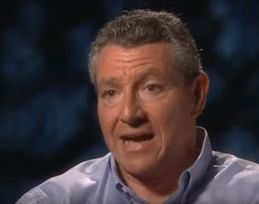
“You always heard rumors that they had this unit in Vietnam that was doing all this clandestine activity but no one was really sure what they were doing,”
– Sgt. Edward A. Helfand – former SOG, US Army
“What did these guys do? Every now and then, you’d run into an old-timer with that thousand-yard stare who just got back. But no one was talking about it,”
– Sgt. Brendon Lyons – former SOG, US Army

“It was almost like you were out of your body and you were watching. But that’s the attitude you have to take in order to survive.”
– Sgt. Edward A. Helfand
“We didn’t want to make contact with the enemy, but it doesn’t work out like that most of the time. The whole idea was to gather intelligence and you would report all this information back to HQ and they would map it out,”
– Sgt. Edward A. Helfand

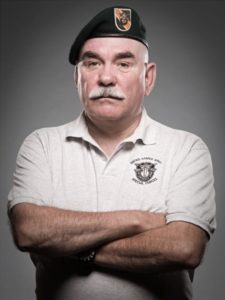
“I will always remember the first SOG brief I got. I finally found out what we were doing, Colonel Jack Warren was wearing a green beret, a black wind-breaker, shower shoes and smoking with a cigarette holder. He flamboyantly threw back this curtain and here’s this map of Southeast Asia. I’m look at one side, which is Vietnam, but all these boxes that are on the west side of the map which is Laos. Then Col. Warren said, ‘Gentlemen, welcome to the covert world,’”
– Major John Plaster – former SOG, US Army
“We would always carry a basic load of 550-600 rounds for the carpet team, about 10 hand grenades and a dozen or more rounds for the M-79 grenade launcher. For the gear, we always carried between 80-90 pounds,”
– Sgt. John S. Meyer – former SOG, US Army
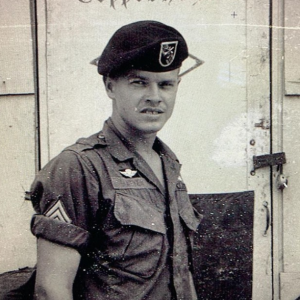

“You always wanted the FAC to know where you were. A good radio operator would let the FAC know they were in a certain location. The reason behind that was if someone shoots at you or you need an immediate exfil, he doesn’t need to search around to find where you are,”
– Sgt. Edward A. Helfand
“Ideally, you’re going to land. Three guys get off, another helicopter would come in and another three guys get off and we’d go on from there. Occasionally, because of the terrain, we would rappel in or go down a ladder,”
– Sgt. 1st Class Cliff Newman – former SOG, US Army
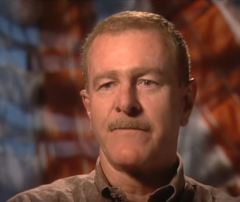

“I remember the sound of the helicopters. You get ready to go into the landing zone and it was very very noisy. You’d get on the ground, the helicopter would take off and all of a sudden, there was silence. All you’d hear is the jungle sounds of bugs,”
– Sgt. Edward A. Helfand
“You’d never talk at all when you’re out in the bush. There were do’s and do not’s. One of the big do not’s was verbally communicating when you’re out in the field. Listen for sounds – that was another key thing I remember was you always listened. You wanted to hear the natural sounds – the birds, the monkeys and insects. Normally, if you didn’t hear that, there was something that might be going on. There may be an ambush being set up. People might be in place, which frightens the animals who may be super quite. So if you heard quiet, normally something was amiss,”
– Sgt. William J. Deacy – former SOG, US Army

“When you do this type of operation, stealth is the most important thing. So you walk very slowly and that’s how you would see a lot of things because the enemy couldn’t hear you. So you’d walk around, stop and use hand signals,”
– Sgt. Edward A. Helfand
“We moved for a whole day. However, the trackers began to close in on us,” Meyers remembered, “They found our trail somewhere. By night, they were within 25-30 feet of us. So first light, we move out and at about 1:30 in the afternoon (we had been moving all day), we got to the top of a little hill and set up there. I called the tactical and said, ‘Try to get somebody in the air because we’re going to have contact here,’
“They finally hit us at about 2:00. They came after us wave after wave and we blew them back down the hill over and over. At one point, they began stacking their bodies up because we had killed so many of them. But when they first opened up, when that first jolt hit, it was almost like an apocalyptic death roar.”
Finally, the air cover arrived including helicopter gunships and A-1E Skyraiders carrying napalm. The mission to target Echo 4 was over. The goal then was to hold the enemy back and bring a helicopter in to carry the SOG team back to base and to safety. The transport helicopter couldn’t get in right on top of the SOG team. Instead, they had to fight their way through 25 foot high elephant grass to reach the chopper, their ride home.
“There stood the helicopter, the gunships are coming around doing gun runs to suppress any fire. We finally get to the helicopter and literally throw everybody in there. It’s just hovering there. I looked up and Captain Tin was just sitting there as cool as a Rocky Mountain breeze, ‘Okay guys, any time you’re ready to go home, I’m ready,’” recalled Sgt. Meyers.
“One minute, you’re feeling trauma to the max. They’re trying to get us the gunships and all this turmoil. We get back to base and all the guys are there like, ‘Hey, you guys got back great!’ and you’re going, ‘Wait a minute! We just barely got out of there!’ Then one of my buddies who was there asked how it had gone and I said ‘really bad’. He wanted to know if we had killed anybody,”
Sgt. Meyer closed by saying, “I had to think about it that that day was the first time I had killed somebody. But in the heat of it, you don’t think about it. And then you talk about it but you just can’t let it bother you. If you didn’t get him, he would have gotten you and you wouldn’t have gone home,”
– Sgt. John S. Meyer – former SOG, US Army


“The North Vietnamese were really good at camouflaging their vehicles during the day, moving them at night and then they’d bring the supplies down into South Vietnam through Laos and Cambodia by vehicle. We were interested in trying to determine where these things came from, what was being carried in them and where they were unloading them and any routes they were using to get into South Vietnam,”
– Col. Steve E. Cavanaugh
“In March 1970, there had been a series of convoys riding on highway 110 in southern Laos right up to the border of South Vietnam. That’s where they would disappear. Supplies were being stockpiled for some major action.”
– Maj. John Plaster


“I still remember that first night as we were laying on a hillside about 2 kilometers from the highway. We could hear the trucks rolling down the road. It was both exciting and fearful. We knew they were there. The next night, we would be down on that highway. We reached it about noon,”
– Maj. John Plaster
“When you fall through rain, it’s like being poked with icicles or icepicks. It was a weird feeling. There I was falling in a rain storm looking at my altimeter wondering where I am. When I opened, I was just coming out of the clouds and I saw the terrain features. It was very dark – about 2:00 in the morning. I landed in the drizzling rain all by myself. I figured that was the stupidest thing I’ve ever done in my entire life!”
– Sgt. Cliff Newman

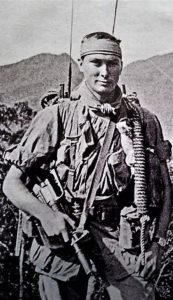
“The enemy knows your tactics as well, if not better, than you do. Learn THEIR tactics and use them against them. Do what they don’t expect you to do”
William T. Barclay
“Don’t be afraid to move. The longer you stay where you are the bigger target you become”
- John Kinstrey
“Cold camps, no fires… you can smell cooking and shit from miles away in the jungl”
Jim Jackson
“Show me where we are on this map”
John Kinstrey
“Go slow, take breaks to listen. It’s not how much ground you cover, it is how much ground you cover without being seen”
Jim Jackson
“My side-arm was a sawed of M79 with a vest of 24 rounds. Used many times”
Rob Graham
“Watch and listen and ask questions”
Tom R Waskovich
“Shit dude, you’re in for an eye-opening experience. I’m Jim Jones, 1-0 of Rt. Delaware, you can call me ‘Wild-Carrot'”
Jim Shorten Jones
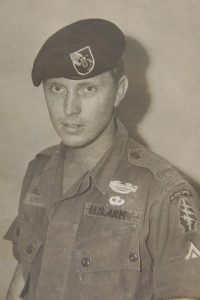
“Keep your fucking mouth shut, your eyes open, and learn as fast as you can if you want a half-ass chance of getting out of this shit alive”
Harold Wayne Hamlin
“Modern society doesn’t recognise its warriors, but they expect to be protected”
James Acre
“STABOs were not fun, but trying to climb a ladder with a 75lb ruck and LBE was not fun, especially when you were climbing horizontal instead of vertical”
Troy Gilley
“The rope was tied into the floor of the slick in a bag and we would hover the pilot over the hole in the trees and throw it out to them.”
Don Haase
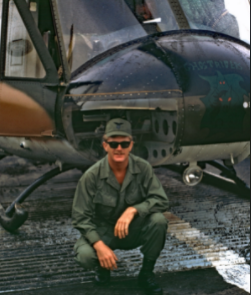
“I did have a door gunner shoot a rocket as it was fired and the motor exploded knocking out everyone and causing damage but I woke up and pulled out of my dive. Just a lucky day.”
Gordon Denniston
“The point on a team would carry a full mag of tracers so when they executed immediate action drill to break contact it looked like more than six or eight people.”
Don Haase

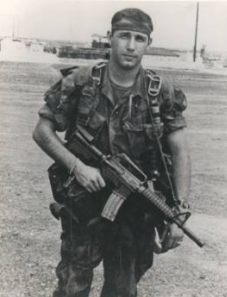
“Out of the jungle, about sunrise, Came four squatty yards and three round eyes, They didn’t make a sound, They didn’t make a squeak, Cause they knew their shit was weak – Recon.”
Ken Bowra
“When we worked with B-52 Delta they had a roadrunner platoon. Three indigenous would dress up in NVA uniforms and weapons. We had to dress them in ponchos to load them on the helicopter. We would go into three LZs and they would get off in one.”
Don Haase


“RPDs were great, but heavy. By 1970 more teams had at least one American carrying an RPD or M-60.”
John Stryker Meyer
“We went into some nasty spots to get the recon guys out. In an LZ at night with red and green tracers going back and forth while the team guys fight their way through the bad guys.”
Don Haase


“A wiretap mission – in slang we referred to it as a ‘Ma Bell’, for our US phone system at the time.”
Ken Bowra
“Our grenadier could stick it up a gnat’s ass at 300yards. Our weapons maniacs also rigged a 40mm round with flechettes. Nasty little buggers.”
John Stryker Meyer

“We all have a joke amongst the recon teams. We think they were crazy for getting off the helicopter. They think we were crazy for staying on. They say we could hide behind things. We say we hid behind our tracers.”
Don Haase
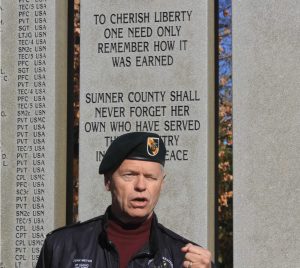
“Team player, or fuck off. We had a 101st Rambo-type transferee come into FOB 1. On his first mission he called an air strike in on his team.”
John Stryker Meyer
“The best thing about the B3 cookie can was that it fit perfectly when empty on the left side feed tray of the M60. Linked ammunition went over it and prevented ammo from twisting and jamming. Every M60 gunner worth his salt did this.”
Ken Bowra


“I packed a handgun until one mission when I fired my last magazine as we rushed to the Huey. THE MOST HELPLESS FEELING YOU CAN HAVE IS TO EXPEND ALL YOUR AMMO. After that I left the handgun and took another rifle mag.”
John Plaster
“For our commo check with Moonbeam, Hillsborough, Covey or Hickory Radio Relay site, I simply broke squelch twice for absolute minimal commo.”
John Stryker Meyer


“The issue black gloves would get black dye on your hands the first time they got wet. Lowest bidder! I cut down middle finger also past the first joint in fingers and down to thumb joint.”
Ken Bowra
“NVA LZ watchers used tree platforms to detect where a SOG insert or extract helo was landing.”
John Plaster


“A team 1-0 convinced a pilot to drop bombs on his team to keep from being overrun. The NVA were so close we could hear them saying ‘come out GI we kill you quickly.’ It worked. All wounded, no medals, no Purple Hearts. A normal day in SOG.”
Don Haase
“The Frenchman doubled back with a 22 standard silenced. When the dog came over the hill he put a round between his stupid eyes. He planted a toe popper which the NVA tracker found a little while later.”
John Stryker Meyer


“The Hueys were based at Pleiku, and the Kingbees at our Kontum compound. Each day the Hueys (and Cobras) flew up from Pleiku, the pilots were briefed, then together the Hueys and Kingbees flew up to the Dak To launch site.”
John Plaster
“Dogs. Some Anti-recon teams had them. We had CS powder in a small squeeze spray container to squirt behind us if needed. Dogs were in every village area. I was in point once and came around a bend off the trail and came face to face with a dog.”
Ken Bowra


“USAF Coveys flew O2 Skymasters, the rear seat crammed with radios, the pilot in the left and Covey Rider in the right seat. Only the right window could be cranked open while in flight. I actually shot out an open window while supporting a team.”
John Plaster
“MACV-SOG was the most highly-decorated Vietnam unit, receiving 11 Medals of Honor and 22 Distinguished Service Crosses. Bob Howard received 8 Purple Hearts along with the MOH and DSC. Billy Waugh had six.”
Don Haase


“My backup weapon was cut down M79, which I carried in a holster on my web belt. Spare 40mm rounds were carried in two 1-quart canteen pouches on my belt.”
Ken Bowra
“The Commando Vault, 15,000-lb bomb, intended for cutting LZs, was used by SOG for LZ prep, in case a team insert location had been compromised by a mole in Saigon. I was flying Covey for two. Looked like a nuke when they detonated.”
John Plaster


“CAR 15 magazines: I tied a loop on the bottom with 550 cord to permit ease in pulling out from pouch. I never taped two magazines together. Awkward and dirt could get in.”
Ken Bowra
“I have been closer than anyone should be to impacting napalm. From the ground, you see a bright aluminum pod rolling end-over-end, and you hear it crash through the treetops. Then comes a low-sounding ‘W-h-u-m-p-f!’ as it ignites.”
John Plaster


“I had all linked RPD ammunition in the drums. One drum in a 2-quart canteen cover on my belt. Total 4 on pistol belt. Another in ruck flap.”
Ken Bowra
“Montagnard resistance groups fought on post-1975. For a number of years the Hanoi press reported fights between the NVA and ‘bandits’ especially in the South’s Central Highlands.”
John Plaster


